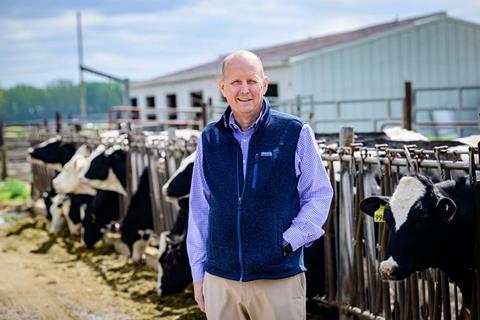Recent reports of the first documented case of the H5N1 virus passing from birds to cows — and then from a cow to a person — have generated a lot of press in an age of worry about diseases “spilling over” from wildlife to agricultural animals and humans.

Dr. James Lowe, a professor of veterinary clinical medicine at the University of Illinois Urbana-Champaign, studies the factors driving viral transmission to, and among, farm animals. He spoke with News Bureau life sciences editor Diana Yates about the latest findings.
How does infection with the H5N1 “bird flu” virus spread among birds, and how might a bird transmit the virus to a mammal?
The H5N1 virus is not a respiratory pathogen in birds. Instead, the virus is transmitted by ingestion of fecal matter from another infected bird, so it’s an oral-fecal route of transmission. We don’t know how the virus passes from birds to mammals. The theory is that the infected cows were exposed to infected birds and their feces. That’s the most likely explanation. We also don’t know how the virus is transmitting between cows.
How serious is the infection among birds, cows and other mammals?
There are highly pathogenic and less pathogenic strains. The “high path” strains of avian influenza kill poultry and some wild birds. The “low path” strains don’t result in high mortality among birds.
We don’t know the mortality rate in marine mammals like seals and sea lions because we don’t know how many of these animals were infected. But thousands of marine mammals have died with H5N1 infection. In these animals, and in carnivores like foxes and cats, the disease causes neurological rather than respiratory problems. Viruses in the brain are often associated with severe disease and high mortality.
In cows, the disease appears to be self-limiting. Many cows may be infected but not affected —that is, the infection is undetectable or causes only mild disease.
In humans with healthy immune systems, infection with the H5N1 virus may be associated with mild respiratory problems, conjunctivitis, gastrointestinal problems or no symptoms at all. In those who are more vulnerable, it may cause severe respiratory distress and even death. To date, human mortality as a result of bird flu infection is extremely low.
Since 2006, when H5N1 was first detected in China, we are not aware of any person-to-person spread of the virus in the U.S. and such cases are extremely rare around the world and tend to be short-lived. Most such cases occurred only after prolonged close contact with an infected person.
While H5N1 infection has repeatedly been found among wild birds the U.S., only two people in the U.S. have so far tested positive for the virus. The most recent case involved someone who worked closely with infected cattle. A 2022 case was linked to exposure to infected poultry.
Why does the virus affect so many species so differently?
The virus interacts with specific sialic acid receptors on the surfaces of cells, and those receptors may be more prevalent in different parts of the body in different groups of animals. In marine mammals and some carnivorous mammals, the virus migrates to the brain to bind to SA receptors there, causing dangerous disease. In humans, the affected receptors are most abundant deep in the lungs. That’s why H5N1 infection sometimes causes pneumonia in humans. In cows, the receptors may be more common in other parts of the body.
Is the fact that bird flu is now infecting cows a cause for worry about a new pandemic of bird flu in humans?
I can’t tell the future, but there’s no indication at present that this will happen. Humans were exposed to bird flu in chickens for a couple of years and we didn’t really see many human cases there.
There’s some evidence that human exposure to other influenza viruses or flu vaccines allow the adult immune system to better recognize the threat, so there may be some cross protection there.
But RNA viruses change continuously. And if you get too confident, that’s when you look real dumb. I know the public loves certainty. And we’d like to say things with certainty. But we probably know a lot less than we’d like to know.
Lowe is an associate dean in the U. of I. College of Veterinary Medicine and an affiliate of the Carl R. Woese Institute for Genomic Biology at Illinois.







No comments yet